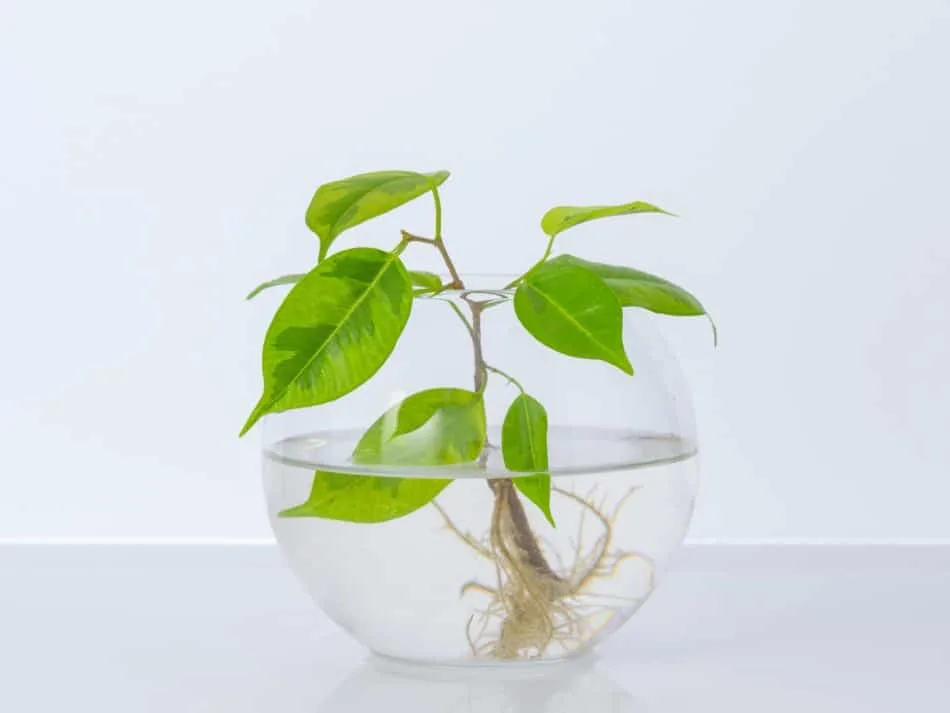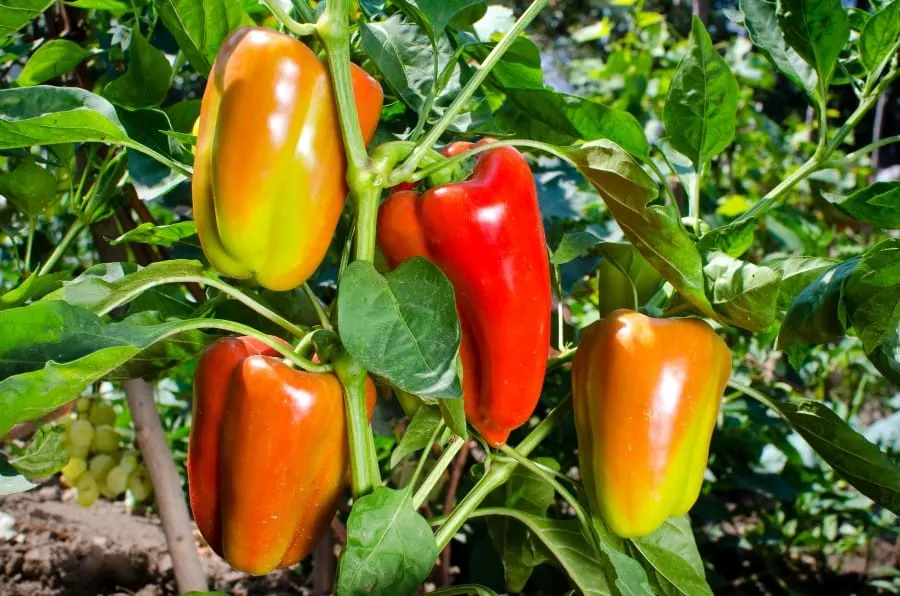For many, growing pepper plants can be a fun and rewarding experience. Unfortunately, sometimes our pepper plants can become damaged or injured beyond repair, which has led some to wonder if they can take a cutting from their plant and use it to grow a new one. So, can you grow a pepper plant from a cutting?
To grow pepper plants from cuttings, begin by cutting a piece from the main stem and stripping it of all but for one or two leaves. Remove any flower buds as well. Next, partially submerge the cutting in a glass of fresh water and wait for roughly three to four weeks for roots to appear.
This article will provide you with an easy to follow step-by-step guide to growing pepper plants from cuttings. We will give some useful tips on encouraging your cuttings to root and suggest some nutrients and hormone solutions that can help it. We will also discuss the timeframe that can be expected for your cuttings to root and whether or not all pepper plants have the ability to be grown from cuttings, so read on!

Can You Grow a Pepper Plant From a Cutting?
Cutting is a process where a single piece of a plant’s stem is removed from its parent and then prepared and nurtured in such a way that it eventually begins to sprout its own roots, at which time it may be planted to form a clone of the original plant.
Plant growers will primarily grow new plants from their cuttings for one of two reasons: their plant has somehow become damaged and destroyed, and they need to propagate a new one, or simply to increase the number of plants that they have, to increase their total yield.
Many different species of plants can be grown from their cuttings, such as rosemary and mint. Thankfully, peppers are a plant that can be grown and regenerated from their cuttings fairly easily.
If it is your first experience trying to get a pepper plant’s cutting to root, you will have a great chance of success by closely adhering to the guide in the following section,.
Step-by-Step Guide to Growing a Pepper Plant from a Cutting
Before we get into how to prepare and process a cutting for cloning a new pepper plant, it should first be noted that not all cuttings will successfully root. Because of this fact, it would be wise to prepare multiple cuttings at one time to increase the likelihood of success.
Follow these steps to grow a new pepper plant from a cutting:
- First, your cutting must be prepared to optimize its energy and focus it on growing new roots. Cut a healthy piece from the stem and then remove all but one or two leaves. The cutting will still require a leaf or two to perform photosynthesis, but leaving too many will expend energy from the stem that could be better spent on rooting. Remove all flower buds that may be attached as well.
- Next, take a glass or a plastic water bottle cut in half, then fill it with enough clean room temperature water to partially submerge your cutting. If the cutting you are using is very small, a tray will be required for it to be placed in. Be sure to replace the water every few days to ensure it is fresh.
- Make sure the cuttings have access to an adequate amount of sunlight per day. This will make all the difference.
- When the roots reach roughly an inch in length, you can now transplant your cutting into a pot of dirt. The roots will begin to appear like little white hairs. In general, one should expect to wait between three to four weeks, but sometimes they can begin to root a week early or late.
- (Optional): Add nutrients or hormones to encourage root growth. If after four weeks your stem is still not showing roots, consider adding growth nutrients or hormones to encourage root growth.
While this is not the only way to clone a pepper plant, and other methods do exist, the method presented above is the simplest and most effective.

How to Encourage a Pepper Plant Cutting to Root
Some cuttings flourish with very little effort or attention given to them, while others tend to be more stubborn and thus require a little more nurturing and nourishment before they will root.
There are a few basic practices that will usually help cuttings to grow and enhance their potential.
As mentioned above, change their water frequently and give them as much direct sunlight as possible throughout the day. Also, make sure the cutting can stand upright with good posture. This may necessitate using some type of lid with a hole cut in it that the stem may sit in for balance for smaller cuttings.
Sometimes, however, a cutting may require even more than this to root.
Nutrient and hormone solutions, specifically designed for rooting stems, may be needed to give the cutting a little bit of help to grow roots.
Nutrient or hormone solutions
When it comes to supplemental additives for helping to root a cutting, there are two different approaches.
Nutrients may be used to encourage the plant cutting to root. The nutrients responsible for root health and growth are nitrogen, phosphorus, and potassium. Providing the cutting with all the nutrients it needs for root growth will create an ideal diet to thrive.
The next supplement that is commonly used to aid in rooting stems is a root stimulating hormone. Contrary to nutrient supplements, which simply give the root a healthy diet to thrive, hormone supplements directly stimulate the cutting to release auxin, the hormone responsible for plant rooting.
We might say simply that nutrients will provide external aid, and hormones will prove internal aid. While both are effective, the latter is sure to yield incredible results.
If you are looking for a plant hormone specifically designed to help with rooting cuttings, try RootBoost Hormone Powder.
How Long Does it Take for a Pepper Plant Cutting To Root?
One of the most common questions by first-time pepper plant cloners is how long it takes for a cutting to root? In general, one should expect to wait between three to four weeks for a stem cutting sprout roots, but sometimes they can begin to root a week early or late.
The two factors that will determine the time it takes for your cutting to begin spawning roots are how well it has been prepared, taken care of, and given the optimal conditions to thrive; and simply how eager and enthusiastic that particular cutting is, which is something you have no control over.
The roots will begin to appear like little white hairs. When the roots reach roughly an inch in length, you can now transplant your cutting into a pot of dirt and watch it grow up.

Can All Pepper Plants be Grown From a Cutting?
Perhaps the best thing about growing pepper plants from cuttings is its universality.
All pepper plants have the potential to be grown from a cutting using the method in this article. So, that includes spicy chili peppers as well as sweeter Bell peppers.
Provided that your cutting is healthy enough to survive the rooting process, you will be able to clone a pepper plant regardless of the type.
Closing Thoughts
If you or a friend already have nice, healthy pepper plants, you might consider using cuttings to grow more.
To do this, prepare a few cuttings by removing all the stem’s leaves but for one or two. From there, you will place the cuttings in a separate cup of fresh, room temperature water that you will change every few days. The last step is simply to wait three to four weeks for the stem to produce roots. Use root hormone or nutrient supplements for the best result.
Here are Some of my Favorite Gardening Products and Tools
Thank you for reading this article. I hope you found it helpful for growing some new plants in your home or garden. Here are some products I like that I hope you’ll also find helpful. These are affiliate links, and I am compensated for referring traffic. But in all honesty, these are the exact product that I use or recommend to everyone.
Soil: For high-quality soil, I really like Fox Farm Ocean Forest. I do all my growing in containers and this soil has worked great for me. I like how they use nutrient-rich contents like earthworm castings, bat guano, and composted crab and fish.
Fertilizer: Currently I am using a seaweed-based organic fertilizer call Neptunes Harvest. This is a great milder fertilizer option if you want to use something organic. If you want a more powerful fertilizer, I recommend Fox Farm Liquid Nutrient Trio, lots of people have had great growing success with this product.
Pruning Shears: Pruning shears are one of the most useful gardening tools to have because it’s important to prune your plants to keep them healthy. The pruning shears I recommend are the Gonicc 8’’ pruning shears. I like them because they are built sturdy and work both on bigger and smaller plants, so you don’t need to have multiple pruning shears.
spicytrio.com is a participant in the Amazon Services LLC Associates Program, an affiliate advertising program designed to provide a means for sites to earn advertising fees by advertising and linking to Amazon.com. spicytrio.com also participates in affiliate programs with other sites. spicytrio.com is compensated for referring traffic and business to these companies.
